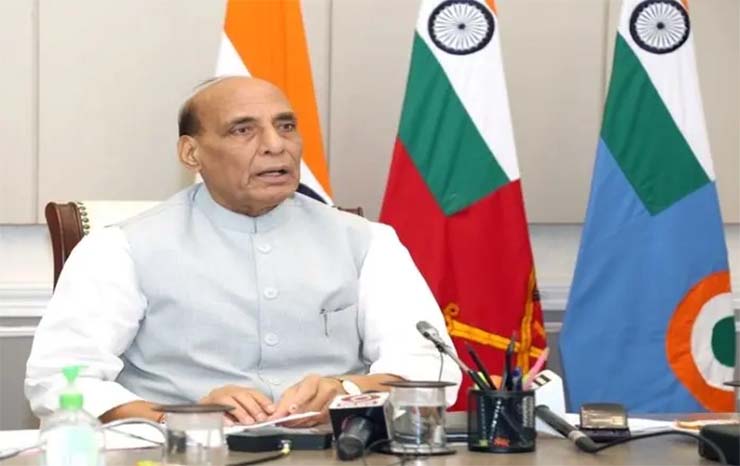
New Delhi: The ministry of defence cleared nine procurement proposals of around Rs 45,000 crore in a fresh push for self-reliance in the defence manufacturing sector on September 15. The approval to purchase military hardware includes new fighter planes, missiles, light armoured multipurpose vehicles, integrated surveillance and targeting systems, and survey ships to modernise its armed forces.
The defence ministry in a statement said, “The Defence Acquisition Council (DAC) has accorded Acceptance of Necessity (AoN) for nine capital acquisition proposals of approx. Rs 45,000 crore.” The AoN refers to the initial approval to any defence acquisition project. The meeting of the DAC that approved the nine proposals was chaired by Defence Minister Rajnath Singh.
“All these procurements will be made from Indian vendors under Buy (Indian-Indigenously Designed Developed and Manufactured (IDMM)/Buy (Indian) category which will give substantial boost to the Indian defence Industry towards achieving the goal of ‘Aatmanirbhar Bharat’,” the defence ministry said. IDDM stands for indigenously designed, developed and manufactured.
According to the defence ministry statement, the weapons and systems will be bought from Indian vendors, giving a substantial boost to the domestic defence Industry. India has set aside a portion of its defence budget to buy locally made military hardware. Around Rs 1 lakh crore was set aside for domestic procurement in this year’s budget, compared to Rs 84,598 crore, Rs 70,221 crore and Rs 51,000 crore in the three previous years.
The proposals cleared by DAC include the purchase of 12 Sukhoi-30 MKI fighter jets and associated equipment worth Rs 11,000 crore from state-run Hindustan Aeronautics Limited (HAL). The fighters will be bought as replacements for the 12 Su-30 MKIs lost in accidents. India had contracted 272 Su-30-MKIs from Russia of which 222 aircraft were licence-built by HAL.
The council also green-lit the purchase of Dhruvastra short-range air-to-surface missiles for the advanced light helicopters (Mk-IV) and integrated surveillance and targeting systems to meet the needs of the mechanised forces.
The next-generation survey vessels and avionics upgrades for Dornier aircraft were also cleared. The go ahead to the Indian Air Force’s (IAF) proposal to carry out the avionics upgrade of the Dornier fleet to improve its accuracy and reliability is considered significant as technical snags on a were reported in the aircraft on a number of occasions earlier this year.
The light armoured multipurpose vehicles and integrated surveillance and targeting systems will enhance protection, mobility, attack capability and survivability of the mechanised forces, the statement said. High mobility towing vehicles for swift mobilisation and deployment of artillery guns and radars were also approved.
The Buy (Indian-IDDM) category covers the acquisition of military hardware from Indian vendors, with a minimum of 50% indigenous content on cost basis of the base contract price. The Buy (Indian) category refers to the acquisition of weapons and systems that may not have been designed and developed indigenously but have an indigenous content of 60% on the cost basis of the base contract price.
“Rather than a threshold of 50% indigenous content for IDDM projects, we should aim for a minimum 60-65% indigenous content,” Defence Minister Rajnath Singh said. The minister directed the chief of defence staff, the three service chiefs, defence secretary and the director general (acquisition) to work towards increasing the minimum indigenous content in consultation with the local industry.
During the last four to five years, India has taken many measures to boost self-reliance in defence, including the creation of a separate budget for buying locally made military hardware, imposing a series of phased import bans, increasing foreign direct investment from 49% to 74% and improving ease of doing business.
Four positive indigenisation lists have been published during the last three years in August 2020, May 2021, April 2022 and October 2022. These lists have imposed a phased import ban on 411 different types of weapons and platforms including light-weight tanks, naval utility helicopters, artillery guns, missiles, destroyers, ship-borne cruise missiles, light combat aircraft, light transport aircraft, long-range land-attack cruise missiles, basic trainer aircraft, airborne early warning and control systems, and multi-barrel rocket launchers. The import ban covers military hardware that is expected to be indigenised during the next five to six years. Import substitution of ammunition, which is a recurring requirement, has been given special emphasis in these lists.
For the first time on the back of key reforms to spur growth in the sector in May, the value of defence production in the country crossed Rs 1 lakh crore. The figure stood at Rs 1,06,800 crore in FY 2022-23 compared to Rs 95,000 crore in FY 2021-22 and Rs 54,951 crore five years ago. India is eyeing a turnover of Rs 1,75,000 lakh crore in defence manufacturing by 2024-25.















